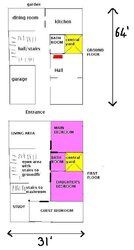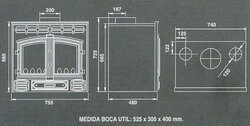- Jan 31, 2007
- 79
BeGreen said:You're doing fine and I understand you. When it's "cool" outside, where do you spend most time as a family? That's where I'd want the heat. The 12 kw should suffice for normal conditions, though weather has ceased to be "normal" for a lot of us. If it's 0C you won't be walking all around in a t-shirt, but as a chill chaser, the stove should really help. If the mistrals don't reach Malta then 12kw may suffice. It will certainly help alot. As for the bath, a simple and safe electric heater can solve that problem quickly. No need to heat it when no one is in there.
Most of the time is spent in the kitchen and dining room as are seen on the ground floor diagram. However, the kitchen with the cooking and the oven generates heat. Both kitchen and dining room have doors, and they are connected to each other by a serving window. That means the heat generated by the cooking there remains in those two rooms quite efficiently.
However we'd be comfortable there but as soon as we open the dining room door to go upstairs the temperature would be chilly compared to the one we've been in. I mostly worry about our 4 year old daughter, going from a warm room to cold... etc... Hopefully a couple of fans placed by the 2 arches as shown in the pictures of my house in the first page of this thread would help dissipate the heat...
The other mostly used rooms are those on the first floor: daughter's bedroom, bathroom and our bedroom.
The company who's going to install our system told us that the best way to do it would be to run the chimney straight up from the hall, straight up through daughter's bedroom, and up through the washroom which (not shown on plan here) is right above daughter's bedroom.
Plainly speaking, daughter's bedroom is one of the warmest rooms since there is building all around. He said the chimney would pass through her bedroom, there would be concrete 'chimney pots' around it, but he'll place a vent at the bottom and another at the top so that heat from between the chimney and chimney pots could escape into the bedroom. I don't think that's bad, considering that the chimney itself would be sealed as a whole unit and no gases could escape, it's just the air from between the chimney and the concrete insulation which would be heating that room.
Then we'd be having 2 ducts.
Note that the ducts do not come directly from the fire compartment itself, they're inbuilt as ducts by the factory in the insert, for the purpose to be used as ducts to other rooms. I'm pointing this out because someone mentioned something about carbon-monoxide danger etc...
One duct will spill into the bathroom upstairs.
The other duct would pass through the false roof (soffit) of same bathroom and exit into the main bedroom.
Right now what we can't decide is this issue: is it better to have a 16KW insert in the hall but which blows forward and through the ducts SIMULTANEOUSLY? Or would it be best to have a smaller 12KW insert which enables us to close the blower to the hall and thus enabling all the heat generated to be redirected to the main bedroom and bathroom?




 I've learnt a ton over here than any agent/installer ever taught me!
I've learnt a ton over here than any agent/installer ever taught me!
